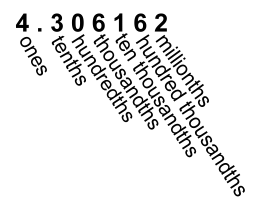 Page Two Rounding Decimal Numbers Rounding a decimal works a little differently. After rounding, the trailing digits (decimal places) are dropped, rather than being changed to zeros. You will need to be familiar with place value names. Here are a few: 
Example 6: Round 4.1895 to the nearest tenth. In the number 4.1895 '1' is the tenths digit. The digit after that is an 8, which is bigger than or equal to 5, so the 1 rounds up to a 2. The rest of the digits are dropped. So 4.1895 rounded to the nearest tenth is 4.2. We know 4.2 has been rounded to the nearest tenth because it has just one decimal place. Example 7: Round 0.834999 to the nearest hundredth. In the number 0.834999, '3' is the hundredths digit. The digit after that is a 4, which is smaller than 5, so the 3 doesn't change. The rest of the digits are dropped. So 0.834999 rounded to the nearest hundredth is 0.83. We know 0.83 has been rounded to the nearest hundredth because it has just two decimal places. Example 8: Round 1,005 to the nearest tenth. In the number 1.005, the first '0' is the tenths digit. The digit after that is a 0, which is less than 5, so the first 0 doesn't change. The rest of the digits are dropped. So 1.005 rounded to the nearest tenth is 1.0. The single 0 must stay, as it shows the number has been rounded to one d.p,. Example 9: Round 0,9999 to the nearest hundredth. In the number 0.9999, the second '9' is the hundredths place The number after that is 9, which is bigger than or equal to 5, so the second 9 rounds up to a 10. The '1' carries left to make the first '9' a 10; that '1' carries left to make the '0' a '1'. Rounding to 2 d.p. we get the answer 1.00 Example 10: Round 5.236501 to the nearest thousandth. In the number 5.236501, the '6' is in the thousandths place The number after that is a 5, which is bigger than or equal to 5, so the 6 rounds up to 7. The rest of the digits are dropped. So 5.236501 rounded to the nearest thousandth is 5.237 Rounding Decimal Numbers: Find the digit you're rounding. The number on its right determines whether it stays the same or goes up by 1. If that number is 5 or bigger, the digit goes up 1; if it's less than 5 the digit stays the same. Numbers following the digit are dropped. If the question asked for rounding to the nearest hundredth, for example, the answer must have exactly two decimal places, even if one or both are zeros |